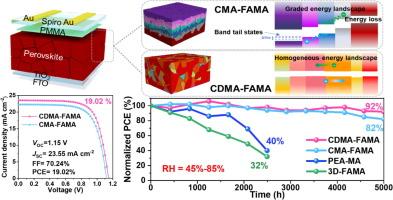准二维钙钛矿中的量子阱工程解锁了光伏电池的效率-稳定性协同作用
IF 14.9
1区 化学
Q1 Energy
引用次数: 0
摘要
准二维钙钛矿为光伏应用提供了增强的稳定性,但由于不受控制的相分离和非理想的量子阱(QW)分布,导致电荷输运受损。与目前普遍认为最大化类3d相可以优化性能的观点相反,我们证明了将量子阱分布缩小到高n相,同时避免不理想的梯度配置(在准2d系统中常见),可以实现前所未有的效率-稳定性协同效应。利用1,4-环己二甲胺(CDMA)作为定向结晶间隔剂,实现了三个方面的进展。(a)具有最小n值色散的高n相建立了均匀的能量格局,显著降低了相间电荷转移障碍并抑制了电压损失。(b)相邻高n相之间的晶格匹配大大减轻了微应变积累,从而减轻了缺陷的产生和非辐射复合。(c)强大的高n相的战略优势实现了双重优化:它排除了吸湿性3d相,消除了限制流动性的低n相,从而确保了有效的电荷动力学,同时增强了钙钛矿的固有相稳定性。这些进步的协同作用使CDMA psc实现了19.02%的冠军效率,使其成为效率最高的准2d DJ psc之一。未封装的装置表现出显著的稳定性,在空气中放置5000小时后保持92%的初始PCE。这项工作重新定义了相位工程的优先级,表明操纵准二维钙钛矿中的量子阱分布有可能解决效率和稳定性之间的权衡问题。本文章由计算机程序翻译,如有差异,请以英文原文为准。

Quantum well engineering in quasi-2D perovskites unlocks efficiency-stability synergy for photovoltaics
Quasi-2D perovskites offer enhanced stability for photovoltaic applications but suffer from compromised charge transport due to uncontrolled phase separation and nonideal quantum well (QW) distribution. Contrary to the prevailing belief that maximizing 3D-like phases optimizes performance, we demonstrate that strategic narrowing QW distribution into high-n phases while avoiding undesirable graded configurations (common in quasi-2D systems) unlocks unprecedented efficiency-stability synergy. Using 1,4-cyclohexanedimethanamine (CDMA) as a crystallization-directing spacer, we realize three advances. (a) High-n phases with minimized n-value dispersion establish a uniform energy landscape, significantly reducing interphase charge transfer barriers and suppressing voltage losses. (b) Lattice matching between adjacent high-n phases substantially alleviates microstrain accumulation, thereby mitigating defect generation and non-radiative recombination. (c) Strategic predominance of robust high-n phases achieves dual optimization: it excludes hygroscopic 3D-like phases and eliminates mobility-limiting low-n phases, thereby ensuring efficient charge dynamics while fortifying the perovskite’s intrinsic phase stability. The synergy of these advances enables the CDMA PSCs to achieve a champion efficiency of 19.02 %, making them among the highest-efficiency quasi-2D DJ PSCs. The unencapsulated device demonstrated remarkable stability, maintaining 92 % of its initial PCE after 5000 h in air. This work redefines phase engineering priorities, demonstrating that manipulating QW distribution in quasi-2D perovskites has the potential to address the efficiency-stability trade-off.
求助全文
通过发布文献求助,成功后即可免费获取论文全文。
去求助
来源期刊

Journal of Energy Chemistry
CHEMISTRY, APPLIED-CHEMISTRY, PHYSICAL
CiteScore
19.10
自引率
8.40%
发文量
3631
审稿时长
15 days
期刊介绍:
The Journal of Energy Chemistry, the official publication of Science Press and the Dalian Institute of Chemical Physics, Chinese Academy of Sciences, serves as a platform for reporting creative research and innovative applications in energy chemistry. It mainly reports on creative researches and innovative applications of chemical conversions of fossil energy, carbon dioxide, electrochemical energy and hydrogen energy, as well as the conversions of biomass and solar energy related with chemical issues to promote academic exchanges in the field of energy chemistry and to accelerate the exploration, research and development of energy science and technologies.
This journal focuses on original research papers covering various topics within energy chemistry worldwide, including:
Optimized utilization of fossil energy
Hydrogen energy
Conversion and storage of electrochemical energy
Capture, storage, and chemical conversion of carbon dioxide
Materials and nanotechnologies for energy conversion and storage
Chemistry in biomass conversion
Chemistry in the utilization of solar energy
 求助内容:
求助内容: 应助结果提醒方式:
应助结果提醒方式:


